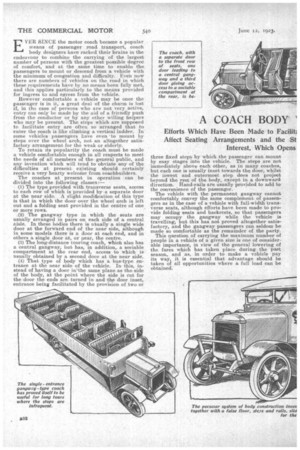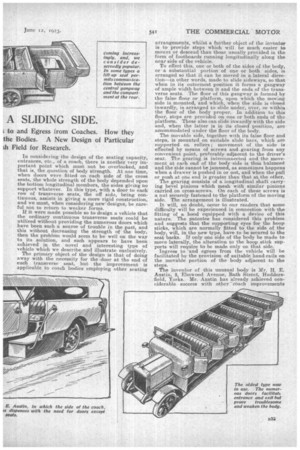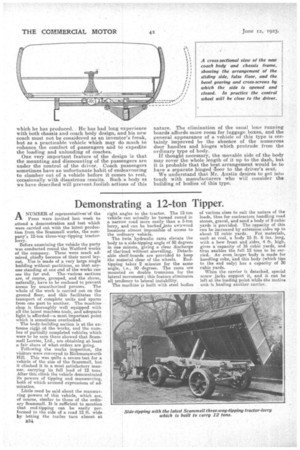A COACH BODY A SLIDING SIDE.
Page 16

Page 17

Page 18

If you've noticed an error in this article please click here to report it so we can fix it.
EVER SINCE the motor coach became a popular means of passenger road transport, coach body designers have racked their brains in the endeavour to combine the carrying of the largest number of persons with the greatest possible degree of comfort, and at the same time to enable the. passengers to mount or descend from a vehicle with the minimum of congestion and difficulty. Even now there are numbers of vehicles on the road in which these requirements have by no means been fully met, and this applies particularly to the means provided for ingress to and egress from the vehicle.
However comfortable a vehicle may be once the passenger is in it, a great deal of the charm is lost if, in the case of persons who are not very active, entry can only be made by the aid of a friendly push from the conductor or by any other willing helpers who may be present. The steps which are supposed to facilitate entry are often so arranged that to enter the coach is like climbing a vertical ladder. In some vehicles passengers have even `to mount by steps over the wheel arch, not an altogether satisfactory arrangement for the weak or elderly.
To retain its popularity the coach must be made a vehicle comfortable enough in all respects to meet the needs of all members of the general public, and any invention which will tend to obviate any of the difficulties at present existing should certainly receive a very hearty welcome from coachbuilders.
The coaches at present in operation can be divided into the fallowing classes:—
(1) The type provided with transverse seats, access to each raw of which is provided by•a separate door at the near side. A slight modification of this type is that in which the door over the wheel arch is left out and a folding seat provided in the centre of one or more rows.
.(2) The gangway type in which the seats are usually arranged in pairs on each side of a. central aisle. In these bodies there is ually a. single wide door at the forward end of the near aide, although in some models there is a door at each end, and in others a single door at, or near, the centre.
(3) The long-distance touring coach, which also has a central gangway, but has, in addition,. a sociable compartment at the rear end, access to which iii usually obtained by a second door at the near side.
(4) That type of body which has a bus-type entrance at the near Bide of the vehicle. In this, instead of having a door in'the same plane as the side of the body, at the point where the side is cut for the door the ends are. turned in and the door inset, entrance being facilitated by the provision of two or three fixed steps by which the passenger can mount by easy stages into the vehicle. The steps are not immediately above each other, as in many coaches, but each one is usually inset towards the door, whilst the lowest and outermost step does not project beyond the rest of the body, except in. a downward direction. Hand-rails are usually provided to add to the convenience of the passenger.
The vehicle with the permanent gangway cannot comfortably convey the same complement of passengers as in the case of a vehicle with full-width transverse seats, although lTorts have been made to provide folding seats and backrests, so that passengers may occupy the gangway while the vehicle is travelling, but this has not proved altogether satisfactory, and the gangway passengers can seldom be made so comfortable as the remainder of the party.
This question of carrying the maximum number of people in a vehicle of a given size is one of considerable importance, in view of the general lowering of the fares which has taken place duringthe paBt season, and as, in order to make a vehicle pay its way, it is essential that advantage should be taken of all opportunities where a full load can be obtained:
In considering the design of the seating capacity, entrances, etc., of a coach, there is another very important point which must not be overlooked, and that is, the question of body strength. At one time, when doors were fitted on each side of the cross seats, the whole strength of the body depended upon the bottom longitudinal members, the sides giving no support whatever. In this type, with a door to each row of transverse seats, the off side, being continuous, assists in giving a more rigid construction, and we must, when considering new'designs,be careful not to return to weaker forms.
If it were made possible so to design a vehicle that the ordinary continuous transverse seats could be utilized without providing the numerous doors which have been such a source of trouble in the past, and this without decreasing the strength of the body, then the problem would seem to be well on the way to its solution, and such appears to have been achieved in the novel and interesting type of vehicle which we describe and illustrate exclusively.
The primary object of the design is that of doing away with the necessity for the ,door at the end of each transverse seat,but the improvement is applicable to coach bodies employing other seating
arrangements, whilst a further object of the inventor is to provide steps which will be much easier to mount or descend than those usually provided in the form of footboards running longitudinally along the near side of the vehicle.
To effect this, one or both of the sides of the body, or a substantial portion of one or both sides, is arranged so that it can be moved in a lateral direction—in other words, made to slide sideways, so that when in its outermost position it forms a gangway of ample width between it and the ends of the transverse seats. .The floor of this gangway is formed by the false floor or .platform, upon which the moving side is mounted, and which, when the side is closed inwardly, is arranged to slide under, over or within the floor of the body proper. In addition to this floor, steps are provided on one or both ends of the platform. These also can slide inwardly with the side and, when the latter is in its closed position, are accommodated under the floor of the body.
The movable side, together with its false floor and steps, is mounted on suitable slide bars, which are supported on rollers ; movement of the side is effected by means of screws and gearing from any convenient point, preferably adjacent to the driver's seat. The gearing is interconnected and the movement at each end of the body•side is thus balanced and the side cannot be jammed, as sometimes happens when a drawer is pushed in or out, and when the pull or_push at one end is greater than that at. the other.
The gearing consists of a longitudinal shaft carrying bevel pinions which mesh with similar pinions carried on cross-screws. On each of these screws is a nut securely fastened to the platform of the moving side. The arrangement is illustrated.
It will, no doubt, occur to our readers that some difficulty will be experienced in connection with the fitting of a hood equipped with a device of this nature. The patentee has considered this problem and suggests that the supporting eyes for the hoop sticks, which are normally fitted to the side of the body, will, in the new type, have to be secured to the seat backs. If only one side of the body be made to move laterally, the alteration to the hoop stick supports will require to be made only on that side.
Ingress to 'and egress from the vehicle will he facilitated by the nrovision of suitable hand-rails on the movable portion of the body adjacent to the steps. The inventor of this unusual body is Mr. H. E. Austin. 2, Elmwood Avenue, Bath Street, Huddersfield, Yorks. Mr. Austin has already achieved considerable success with other -coach improvements
which he has produced. He has had long experience with both chassis and coach body design, and his new coach must not be considered as an inventor's freak, but as a practicable vehicle which may do much to enhance the comfort of passengers and to expedite the loading and unloading of coaches. One very important feature of the design is that the mounting and dismounting of the passengers are under the control of the driver. Coach passengers sometimes have an unfortunate habit of endeavouring to clamber out of a vehicle before it comes to rest, occasionally with disastrous results. Such a body as we have described will prevent.foolish actions of this nature. The elimination of the usual long running boards affords more room for luggage boxes, and the general appearance of a vehicle of this type is certainly improved by the absence of the numerous door handles and hinges which protrude from the ordinary type of body. If thought necessary, the movable side of the body may cover the whole length of it up to the dash, but it is probable that the best arrangement would be to have a separate hinged aoor to the driver's seat. We understand that Mr. Austin desires to get into touch with manufacturers who will consider the building of bodies of this type.






























